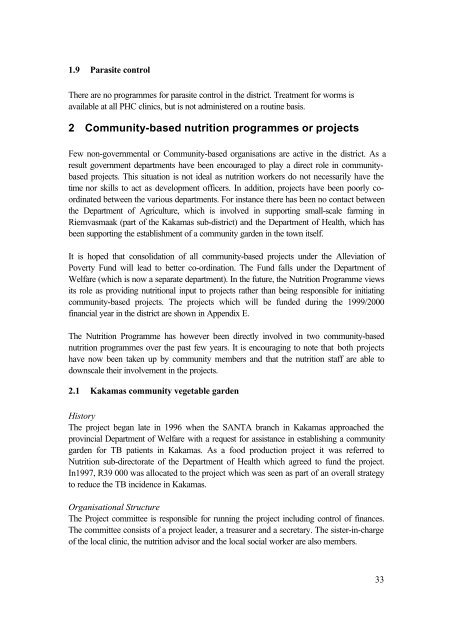Implementing an Integrated Nutrition Programme - Health Systems ...
Implementing an Integrated Nutrition Programme - Health Systems ...
Implementing an Integrated Nutrition Programme - Health Systems ...
You also want an ePaper? Increase the reach of your titles
YUMPU automatically turns print PDFs into web optimized ePapers that Google loves.
1.9 Parasite control<br />
There are no programmes for parasite control in the district. Treatment for worms is<br />
available at all PHC clinics, but is not administered on a routine basis.<br />
2 Community-based nutrition programmes or projects<br />
Few non-governmental or Community-based org<strong>an</strong>isations are active in the district. As a<br />
result government departments have been encouraged to play a direct role in communitybased<br />
projects. This situation is not ideal as nutrition workers do not necessarily have the<br />
time nor skills to act as development officers. In addition, projects have been poorly coordinated<br />
between the various departments. For inst<strong>an</strong>ce there has been no contact between<br />
the Department of Agriculture, which is involved in supporting small-scale farming in<br />
Riemvasmaak (part of the Kakamas sub-district) <strong>an</strong>d the Department of <strong>Health</strong>, which has<br />
been supporting the establishment of a community garden in the town itself.<br />
It is hoped that consolidation of all community-based projects under the Alleviation of<br />
Poverty Fund will lead to better co-ordination. The Fund falls under the Department of<br />
Welfare (which is now a separate department). In the future, the <strong>Nutrition</strong> <strong>Programme</strong> views<br />
its role as providing nutritional input to projects rather th<strong>an</strong> being responsible for initiating<br />
community-based projects. The projects which will be funded during the 1999/2000<br />
fin<strong>an</strong>cial year in the district are shown in Appendix E.<br />
The <strong>Nutrition</strong> <strong>Programme</strong> has however been directly involved in two community-based<br />
nutrition programmes over the past few years. It is encouraging to note that both projects<br />
have now been taken up by community members <strong>an</strong>d that the nutrition staff are able to<br />
downscale their involvement in the projects.<br />
2.1 Kakamas community vegetable garden<br />
History<br />
The project beg<strong>an</strong> late in 1996 when the SANTA br<strong>an</strong>ch in Kakamas approached the<br />
provincial Department of Welfare with a request for assist<strong>an</strong>ce in establishing a community<br />
garden for TB patients in Kakamas. As a food production project it was referred to<br />
<strong>Nutrition</strong> sub-directorate of the Department of <strong>Health</strong> which agreed to fund the project.<br />
In1997, R39 000 was allocated to the project which was seen as part of <strong>an</strong> overall strategy<br />
to reduce the TB incidence in Kakamas.<br />
Org<strong>an</strong>isational Structure<br />
The Project committee is responsible for running the project including control of fin<strong>an</strong>ces.<br />
The committee consists of a project leader, a treasurer <strong>an</strong>d a secretary. The sister-in-charge<br />
of the local clinic, the nutrition advisor <strong>an</strong>d the local social worker are also members.<br />
33
















